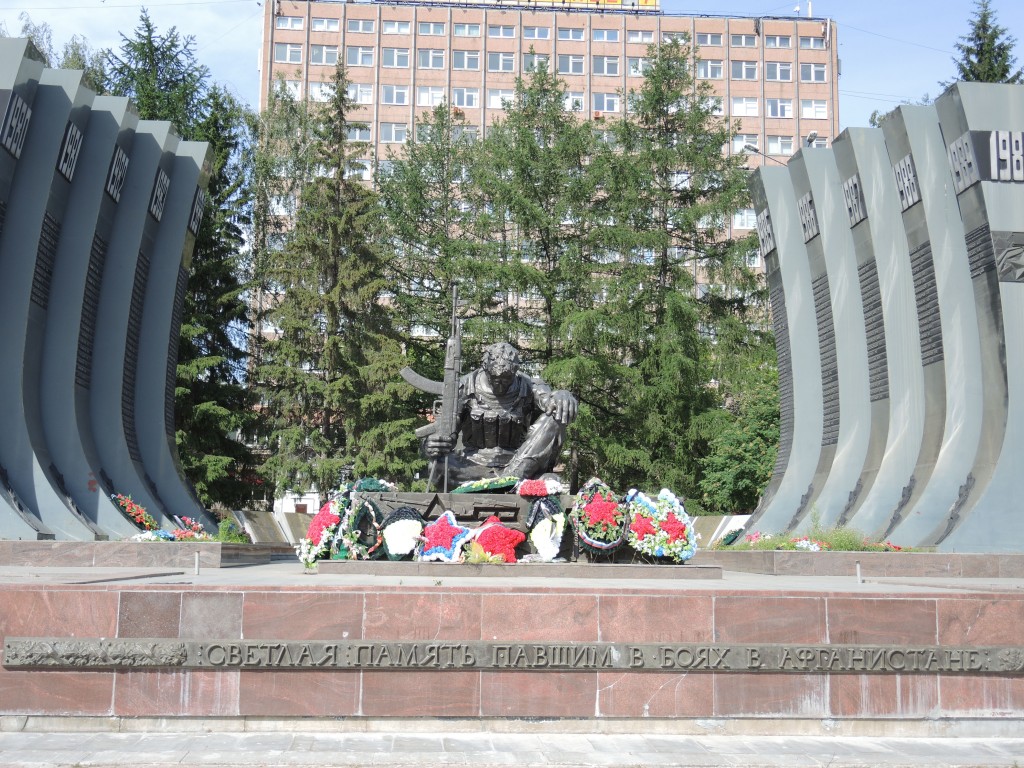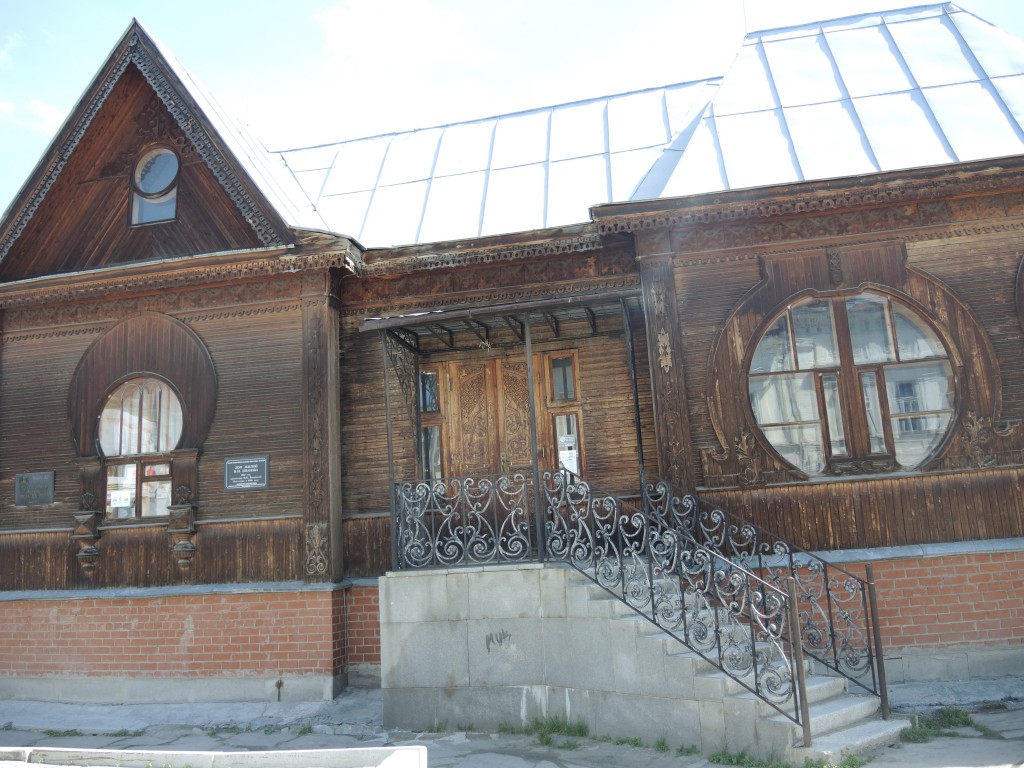15 June Morning.
As I mentioned in yesterday’s entry, the Park Inn is a Radisson hotel and the complimentary breakfast they offer, while not on a par with the breakfast offered at the Table Bay Hotel in Cape Town, is more than ample for anyone’s taste and downright luxurious for this trip. I loaded my plate with some scrambled eggs, a pancake, some lovely crusty bread, and more of the smoked salmon than I’m willing to admit in writing. Had you wanted hot cereal, cold cereal, fresh fruit, bacon, sausage, or an assortment of cold sliced meats, this buffet would accommodate you and that’s only the food I can recall.
We met our guide, Natalia, in the lobby at 10:00 and, with a threat of rain in the air, set out on our walking of Yekaterinburg. Having posited her expertise, I felt immediately that Natalia would be a top-notch guide. She was personable, energetic and spoke English with an ease and fluency none of our previous guides had displayed. Lu had gone ahead to purchase tickets for herself, Ana, and me to a performance of Ohad Naharin’s Deca Dance to be performed by a visiting Israeli dance troupe. Intended or not, I enjoyed the pun in the name and thought it a particularly appropriate and somewhat ironic name and performance for a formerly closed city of the Soviet Union. We met Lu at the theater.
Our first stop was the military quarter. I think I mentioned that under the Soviet regime Yekaterinburg was called Sverdlovsk. The name honored Yakov Sverdlov who was a Bolshevik Party leader, a close ally of Lenin’s, and according to some historians, played a role in the execution of the Romanov family in 1918.
In the 1930’s, the Soviet government began locating heavy industry in the area and, during World War II (or as the Russians refer to it “The Great Patriotic War”), brought a concentrated military presence to the city. In fact, because of its distance from war affected areas such as Leningrad (now Saint Petersburg) parts of the Hermitage Museums collections were also hidden here during the war. Natalia pointed out the former military headquarters that now houses the Military Museum where, among the highlights of the collection, one can find some relics of debris from Gary Powers’ U-2 spy plane. A short distance from this museum is the moving “Black Tulip” Memorial. This is an unusual war monument in Russia because it depicts the losses rather than the heroism of war.
This memorial itself honors soldiers from Yekaterinburg who were killed during the decade long Soviet war in Afghanistan. Black Tulip was the name given to the aircraft that transported the fallen soldiers. The sculpture symbolically echoes the fuselage of the plane. The weary soldier sitting in the center mourning the loss of his comrades adds an additional somber feeling to the memorial. In one of the photos in this folder, you can see that a memorial for Chechnya has been added to it.
Our next stop was the Church on the Spilled Blood in the religious quarter. The church was consecrated in June 2003 and was built on the site of the Ipatiev House where Czar Nicholas II and his family were imprisoned for seventy-eight days before being summarily executed in July 1918. Nikolai Ipatiev was a military engineer who had acquired the house from a gold dealer in 1908. The local Soviet government ordered him to vacate the house in April 1918 and it became known as the House of Special Purpose.
In the 1920s the Soviet press began running photos of the house calling it the “last palace of the last Tsar” and sometime in the 1930s it became the Anti-Religious Museum. By the seventies, after it had been designated a historical revolutionary monument, it had also become, embarrassingly for the Soviet government, a place for people to come to honor the memory of the last imperial family. In 1977, prior to the sixtieth anniversary of the execution of the Romanovs, the central government decreed that the house was not of sufficient historical significance and ordered the local party chair to raze the structure. The man who reluctantly oversaw that demolition was Boris Yeltsin. Still, pilgrims who viewed the Romanovs as martyrs continued to visit the site and after the breakup of the Soviet Union this church was built in that location.
No photographs were allowed inside but the building contains an upper church and a lower church. The upper area has a section with icons to various Russian Orthodox saints and a main ornate cathedral where services are held twice daily. The lower church is darker and more contemplative. It includes a reconstruction of the basement room where the Romanovs were executed that is built on that precise location. The compound also has a residence for the Patriarch of the Church when he is in Yekaterinburg.
Just prior to leaving the religious quarter, Natalia took us to a statue of Peter and Fevronia. The folk tale surrounding this couple goes something like this:
After slaying a snake with a magic sword, Peter, who is a member of the royal family in Murom – a principality east of Moscow – finds his body is covered with aching sores that no doctors can cure. Peter hears about a wise young peasant woman named Fevronia who promises to heal him and as a reward, she wants to marry him. Peter promises to marry her and she cures him but he breaks his promise and his malady returns. He returns to her and she heals him again. This time he keeps his promise. When Peter’s brother dies, he and Fevronia come to rule in Murom but the military nobles are unhappy being ruled by a peasant woman. They ask her to leave the city taking with her any riches she desires. She asks only for Peter. With no royal family, a civil war breaks out and Peter and Fevronia are asked to return. They do and rule in peace and prosperity until they die on the same day. They are buried in the same grave.
Our next stop was the literary quarter which many consider the historic heart of Yekaterinburg. It’s notable for its restored wooden buildings dedicated to the city’s literary heritage. Each of the buildings commemorates either a period of literary history or a specific author.
As we walked along the Iset River, Natalia provided considerably more information about the city but I’d tired of making notes and wanted to simply enjoy the walk. I recall her mentioning that there are 30 colleges and universities in the city.
Near the end of the tour a small group of people approached us telling Natalia that their mission for the day was to spread smiles. We all smiled and exchanged pleasantries as well as we could. Then they broke into song and we all danced in a delightful unplanned diversion. Sadly, I was too caught up in the smiling and my Elaine Benes worthy dancing to take any pictures. I did, however, manage to snap two photos of another “thrilling” event. Our tour fell on Saturday so, when we reached the 1905 square with its statue of Lenin, the Communist Party was holding its (largely ignored) weekly rally trying to enlist new members. I was impressed with the woman who was 
speaking because she seemed to go on and on without pausing to breathe.
We reached the end of our tour and prepared to say our goodbyes but Natalia seemed to enjoy our group so she joined us for lunch as we returned to Vainera Street and ate at a local bakery. By that time Vladim (our transportation coordinator) had also joined the group and he also ate lunch with us.
His behavior was both humorous and inappropriate. He was humorous in the sense that he behaved like a stereotypical Soviet Russian. (He did appear old enough – I’d judge him to be in his late forties – to have been an active member of the Communist Party prior to 1991.) He maintained that Russia either invented everything of worth or is superior in its manufacturing. At one point, he tried to convince Erin and me that the Statue of Liberty was made from Ural iron and was a gift from Russia to the United States. Perhaps he believed this or perhaps he was convincingly playacting for us. It was amusing regardless.
He was inappropriate in the way he attached himself to the group as we set off down Vainera Street after lunch ostensibly he implied he could add something to our tour but his true purpose seemed to be to force his unwanted attention on one of the women in our group.
I have more to write about our visit to this interesting city including accidentally happening upon a remarkable coincidence and an interesting and entertaining evening.



Where’s the picture of the statue of Fevronya and Peter?
It’s in the linked Photos album but as a full service pedant, I’ll add it just for you.
Hello there, I discovered your website by means of Google at the same time as looking for a similar subject, your web site came up, it appears great.
Thank you for sharing. MK